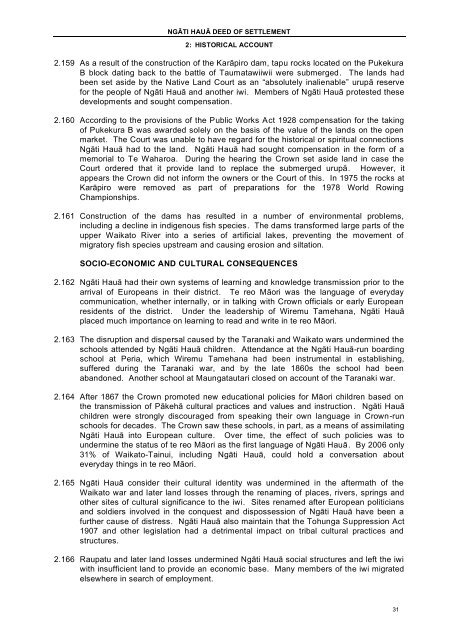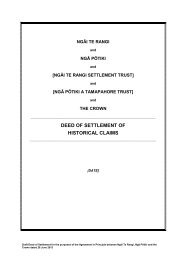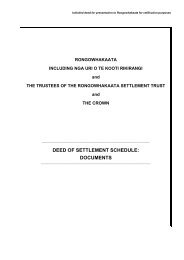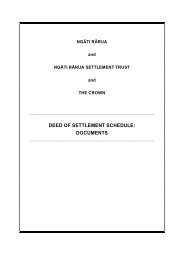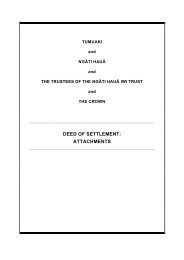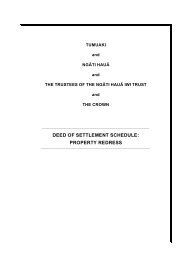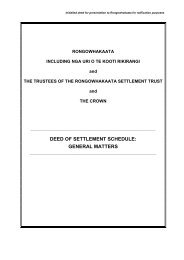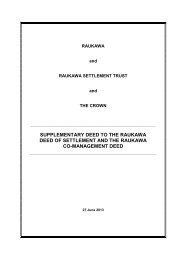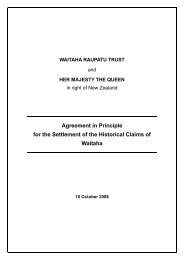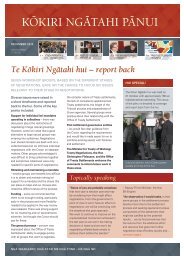Ngati Haua Deed of Settlement - Terabyte Interactive
Ngati Haua Deed of Settlement - Terabyte Interactive
Ngati Haua Deed of Settlement - Terabyte Interactive
Create successful ePaper yourself
Turn your PDF publications into a flip-book with our unique Google optimized e-Paper software.
NGĀTI HAUĀ DEED OF SETTLEMENT2: HISTORICAL ACCOUNT2.159 As a result <strong>of</strong> the construction <strong>of</strong> the Karāpiro dam, tapu rocks located on the PukekuraB block dating back to the battle <strong>of</strong> Taumatawiiwii were submerged. The lands hadbeen set aside by the Native Land Court as an “absolutely inalienable” urupā reservefor the people <strong>of</strong> Ngāti Hauā and another iwi. Members <strong>of</strong> Ngāti Hauā protested thesedevelopments and sought compensation.2.160 According to the provisions <strong>of</strong> the Public Works Act 1928 compensation for the taking<strong>of</strong> Pukekura B was awarded solely on the basis <strong>of</strong> the value <strong>of</strong> the lands on the openmarket. The Court was unable to have regard for the historical or spiritual connectionsNgāti Hauā had to the land. Ngāti Hauā had sought compensation in the form <strong>of</strong> amemorial to Te Waharoa. During the hearing the Crown set aside land in case theCourt ordered that it provide land to replace the submerged urupā. However, itappears the Crown did not inform the owners or the Court <strong>of</strong> this. In 1975 the rocks atKarāpiro were removed as part <strong>of</strong> preparations for the 1978 World RowingChampionships.2.161 Construction <strong>of</strong> the dams has resulted in a number <strong>of</strong> environmental problems,including a decline in indigenous fish species. The dams transformed large parts <strong>of</strong> theupper Waikato River into a series <strong>of</strong> artificial lakes, preventing the movement <strong>of</strong>migratory fish species upstream and causing erosion and siltation.SOCIO-ECONOMIC AND CULTURAL CONSEQUENCES2.162 Ngāti Hauā had their own systems <strong>of</strong> learning and knowledge transmission prior to thearrival <strong>of</strong> Europeans in their district. Te reo Māori was the language <strong>of</strong> everydaycommunication, whether internally, or in talking with Crown <strong>of</strong>ficials or early Europeanresidents <strong>of</strong> the district. Under the leadership <strong>of</strong> Wiremu Tamehana, Ngāti Hauāplaced much importance on learning to read and write in te reo Māori.2.163 The disruption and dispersal caused by the Taranaki and Waikato wars undermined theschools attended by Ngāti Hauā children. Attendance at the Ngāti Hauā-run boardingschool at Peria, which Wiremu Tamehana had been instrumental in establishing,suffered during the Taranaki war, and by the late 1860s the school had beenabandoned. Another school at Maungatautari closed on account <strong>of</strong> the Taranaki war.2.164 After 1867 the Crown promoted new educational policies for Māori children based onthe transmission <strong>of</strong> Pākehā cultural practices and values and instruction . Ngāti Hauāchildren were strongly discouraged from speaking their own language in Crown-runschools for decades. The Crown saw these schools, in part, as a means <strong>of</strong> assimilatingNgāti Hauā into European culture. Over time, the effect <strong>of</strong> such policies was toundermine the status <strong>of</strong> te reo Māori as the first language <strong>of</strong> Ngāti Hauā. By 2006 only31% <strong>of</strong> Waikato-Tainui, including Ngāti Hauā, could hold a conversation abouteveryday things in te reo Māori.2.165 Ngāti Hauā consider their cultural identity was undermined in the aftermath <strong>of</strong> theWaikato war and later land losses through the renaming <strong>of</strong> places, rivers, springs andother sites <strong>of</strong> cultural significance to the iwi. Sites renamed after European politiciansand soldiers involved in the conquest and dispossession <strong>of</strong> Ngāti Hauā have been afurther cause <strong>of</strong> distress. Ngāti Hauā also maintain that the Tohunga Suppression Act1907 and other legislation had a detrimental impact on tribal cultural practices andstructures.2.166 Raupatu and later land losses undermined Ngāti Hauā social structures and left the iwiwith insufficient land to provide an economic base. Many members <strong>of</strong> the iwi migratedelsewhere in search <strong>of</strong> employment.31


